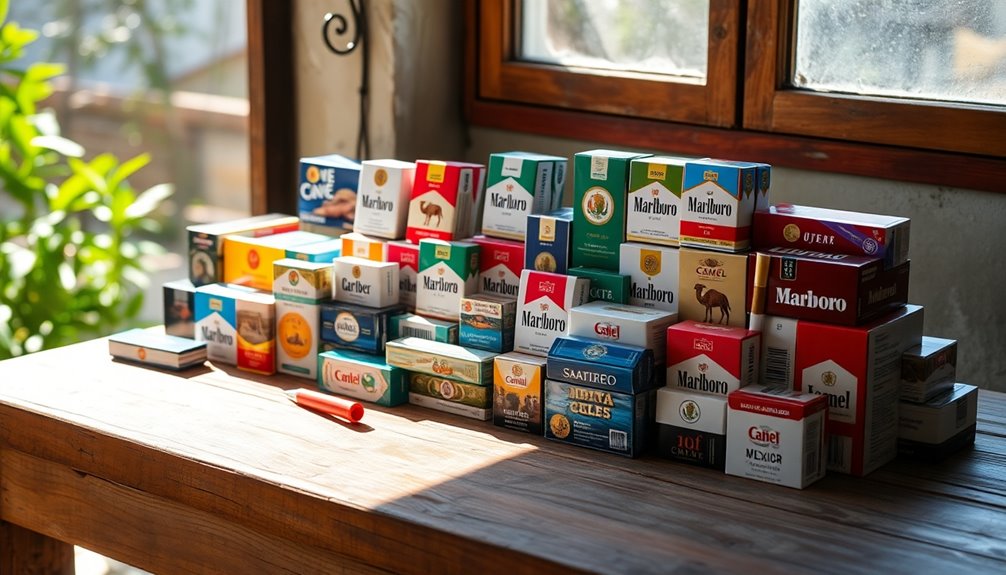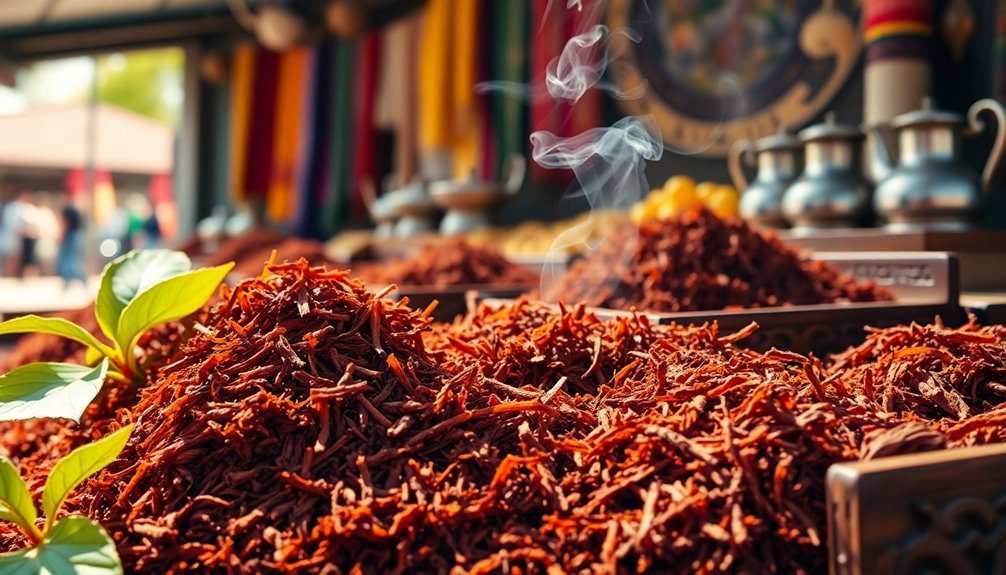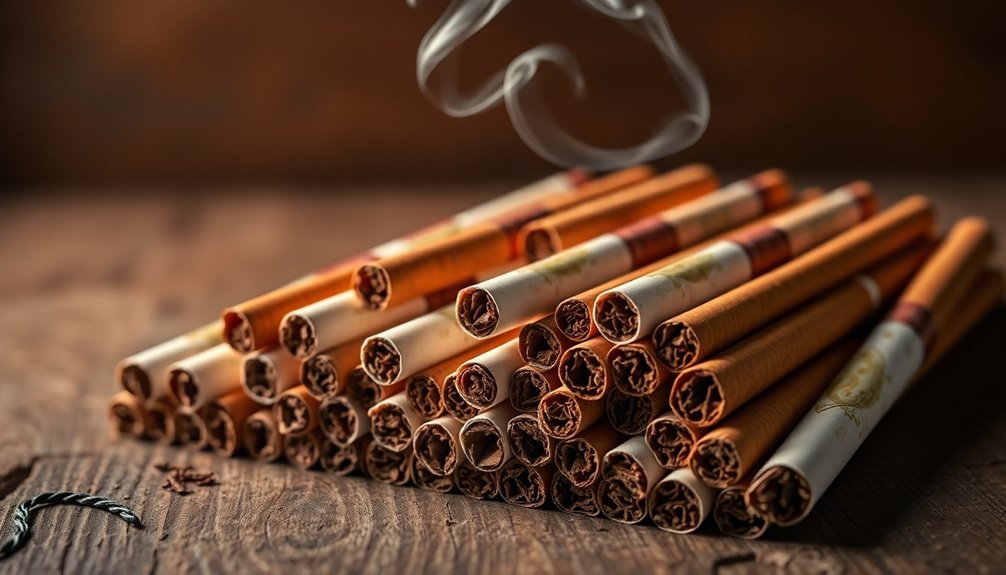If you're exploring cigarette brands in Mexico, you'll find a market worth nearly 89 billion pesos. Marlboro stands out, dominating with over 48% market share, thanks to strong loyalty among smokers. Pall Mall follows, recognized for its affordability and holding nearly 22% of sales. Philip Morris International and British American Tobacco lead the industry, making it a competitive landscape. Preference for flavored cigarettes is also on the rise, especially among younger smokers. With health concerns influencing trends, the landscape is shifting. Stick around to uncover more about how these brands are adapting to current consumer habits.
Key Takeaways
- Marlboro is the leading cigarette brand in Mexico, commanding over 48% of the market share.
- Philip Morris International holds the largest market share at 60%, followed by British American Tobacco with 36%.
- Pall Mall, known for its affordability, captures nearly 22% of the market.
- Flavor Capsule Cigarettes are popular among younger smokers, making up 28% of total cigarette sales.
- The illicit tobacco trade complicates the market, accounting for an estimated 8.8% of sales in 2021.
Overview of the Tobacco Market

The tobacco market in Mexico is a significant player in the country's economy, valued at nearly 89 billion pesos (about US$4.5 billion) in 2022. Cigarettes make up the majority of this market, with Philip Morris International dominating with a 60% market share. British American Tobacco follows with a 36% share, while Japan Tobacco International holds a mere 4%.
Marlboro leads the pack, boasting over 48% of the market. Flavored capsule cigarettes are also gaining popularity, capturing nearly 28% of sales and appealing strongly to younger smokers.
However, the illicit tobacco trade complicates the landscape, estimated to account for 8.8% of the market in 2021. This illegal sector poses challenges to legal sales and regulation enforcement.
The economic impact of tobacco use in Mexico is significant, with health-related costs reaching approximately US$5.1 billion annually. The burden on healthcare systems underscores the need for effective regulations and public health initiatives.
As you explore the nuances of this industry, it's essential to understand its complexities, from market dynamics to the implications of illicit trade and health costs.
Leading Cigarette Brands

Cigarette brands in Mexico showcase a competitive landscape, with Marlboro standing out as the market leader, capturing over 48% of sales. Philip Morris International dominates the cigarette market with a 60% share, while British American Tobacco follows closely at 36%. Pall Mall, another key player, holds under 22% of the market.
Here's a quick overview of the leading cigarette brands:
| Brand | Market Share (%) | Notable Features |
|---|---|---|
| Marlboro | 48% | Iconic brand, strong loyalty |
| Pall Mall | <22% | Affordable option, popular |
| Flavor Capsule | 28% | Appeals to younger smokers |
| British American Tobacco | 36% | Diverse portfolio |
| Japan Tobacco Intl. | 4% | Niche market presence |
Despite the rise of e-cigarette usage among adults sitting at 1.6%, traditional brands remain strong. However, the illicit tobacco trade, accounting for about 8.8% of the market, poses challenges for legal brands. With the growth of flavor capsule cigarettes, the market continues adapting to consumers' evolving preferences.
Market Share Insights
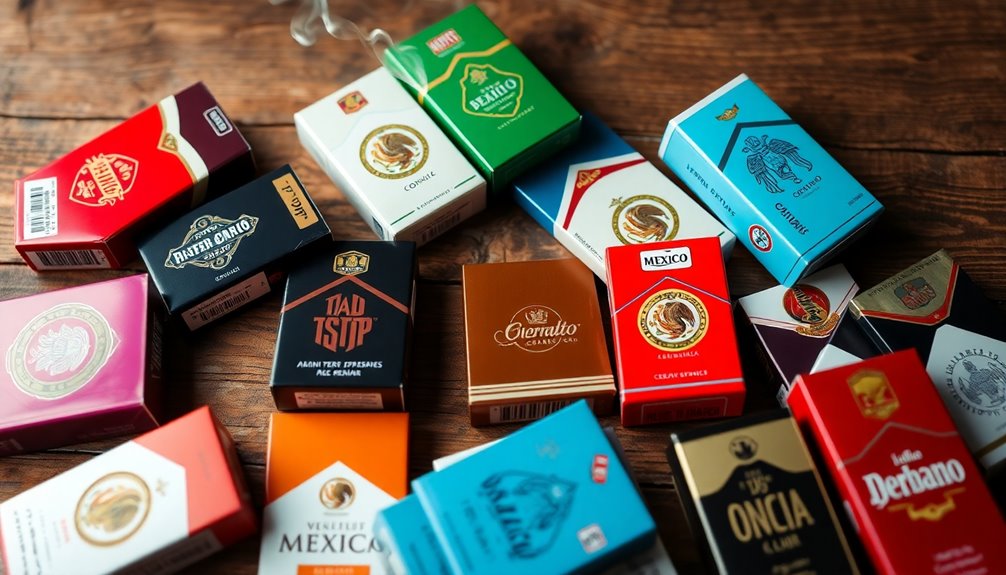
In Mexico's cigarette market, understanding market share is essential for grasping the competitive landscape.
You'll notice that Philip Morris International and British American Tobacco dominate the scene, with Marlboro leading the pack.
Let's explore how these brands influence market trends and what that means for consumers like you.
Leading Brands Overview
How does the competitive landscape of cigarette brands in Mexico shape consumer choices? With a market valued at nearly 89 billion pesos, the dynamics of cigarette brands heavily influence what you smoke.
Philip Morris International dominates the market with a staggering 60% share, leading to distinct consumer preferences.
Here are the top contenders in the market:
- Marlboro: Capturing over 48% of the cigarette share, it's the most recognized brand.
- Pall Mall: Holding under 22%, this brand appeals to a diverse demographic.
- Flavour Capsule Cigarettes: Making up nearly 28% of consumer preferences, these innovative products are gaining traction.
- Illicit Tobacco Trade: Representing 8.8% of the market, it challenges legal brands and impacts visibility.
The competition isn't just among traditional cigarette brands. As younger demographics shift towards e-cigarettes and vaping products, traditional brands must adapt their strategies.
This changing landscape not only reflects consumer preferences but also underscores the challenges posed by the illicit tobacco trade. Understanding these factors can help you navigate the myriad options available in the Mexican tobacco market.
Market Share Trends
The competitive environment in Mexico's tobacco market reveals shifting market share trends that influence consumer choices. As of 2022, the market was valued at nearly 89 billion pesos (US$4.5 billion), with Philip Morris International dominating 60% of the cigarette market. Marlboro leads with over 48% market share, followed closely by Pall Mall at under 22%.
One notable trend is the rising popularity of flavor capsule cigarettes, which now account for nearly 28% of the market. These products resonate strongly with younger smokers, altering traditional buying patterns.
However, the cigarette market grapples with significant challenges, including the illicit tobacco trade, which represented 8.8% of the market in 2021. This illegal segment complicates regulatory efforts and impacts legal sales.
Moreover, health concerns and increasing regulatory pressures continue to shape brand strategies and consumer preferences. Companies are adapting to these dynamics, working hard to maintain market share while addressing the rising demand for transparency and safer alternatives.
As you explore the evolving landscape, it's crucial to contemplate how these factors will influence your choices in the future.
Consumer Trends in Smoking

As you explore the smoking landscape in Mexico, you'll notice that health awareness is shaping how people view traditional cigarettes.
Many are shifting towards e-cigarettes, especially younger smokers, while brand loyalty remains a powerful force in the market.
This evolving trend highlights a complex interplay between consumer preferences and brand strategies.
Health Awareness Impact
There's a noticeable shift in smoking trends in Mexico, driven by increasing health awareness among the population. This growing consciousness has led to a decline in smoking prevalence, currently at 19% among adults.
However, challenges remain as the tobacco industry continues to market aggressively to youth. Here are some key factors influencing this trend:
- Economic Burden: Tobacco use costs Mexico about US$8.2 billion annually, highlighting serious public health concerns.
- Consumer Preferences: A notable shift towards e-cigarettes reflects a desire for perceived less harmful alternatives, especially among younger demographics.
- Flavored Cigarettes: These products appeal to youth, increasing smoking initiation rates despite rising health awareness.
- Youth Marketing: The tobacco industry's targeted marketing via social media complicates efforts to combat smoking trends, as they exploit the shift in consumer preferences.
As you navigate this evolving landscape, it's essential to understand how health awareness is shaping your choices and the broader implications for public health.
Balancing consumer desires with health concerns will continue to challenge the smoking narrative in Mexico.
Shift to E-Cigarettes
A noticeable trend is emerging in Mexico's smoking landscape as more consumers turn to e-cigarettes. Currently, e-cigarette usage among adults sits at 1.6%, while youth usage is slightly higher at 1.8%. This modest growth reflects a rising interest in alternative smoking products, particularly among younger demographics.
As health awareness influences smoking habits, many are exploring these options. Flavored e-cigarettes and vaping products are gaining traction, appealing to those seeking unique flavor experiences that traditional cigarettes can't provide.
The shift to e-cigarettes is also a response to increasing regulatory pressures on traditional tobacco products, prompting some smokers to seek out alternatives that may offer a perception of reduced harm.
However, despite this shift, brand loyalty remains robust among traditional cigarette users. This loyalty highlights the complexity of the tobacco market, where preferences are diverse and evolving.
As you navigate these changes, it's clear that e-cigarettes are carving out a niche, particularly among the youth, while traditional cigarette users maintain their steadfast habits. Understanding these trends can provide valuable insights into the future of smoking in Mexico.
Brand Loyalty Trends
The strong brand loyalty among Mexican smokers remains evident, even as e-cigarettes gain popularity. Major brands like Marlboro and Chesterfield continue to dominate the market, showcasing the consumer trust that drives loyalty.
Despite increasing health awareness, many smokers stick to traditional cigarettes, revealing their deep-rooted attachment to familiar products.
Here are some key trends in brand loyalty among Mexican smokers:
- Premium Brands: Smokers often prefer premium brands, associating them with quality and status.
- Flavored Cigarettes: Nearly 28% of the market consists of flavored cigarettes, which attract younger consumers and influence loyalty.
- Economic Factors: With tobacco's economic burden at US$8.2 billion annually, smoking habits may shift, but loyalty to preferred brands remains strong.
- Smoking Prevalence: Although smoking prevalence dropped from 30% in 2002 to 19% in 2019, brand loyalty continues to play a significant role in the smoking culture.
Health Impacts of Smoking
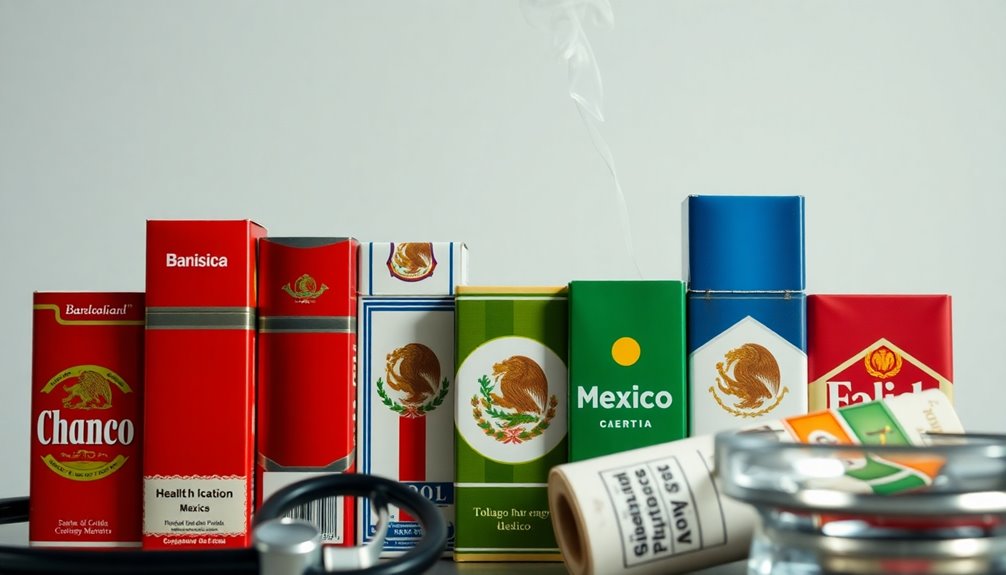
Smoking poses significant health risks, especially in Mexico, where nearly 48,400 people died from smoking-related causes in 2019. With a smoking prevalence of 19% among adults, the impact on health costs and the economy is staggering. Tobacco use accounts for about 6.6% of total mortality, emphasizing the urgent need for effective tobacco control measures.
| Statistic | Value | Implications |
|---|---|---|
| Adult Smoking Prevalence | 19% | High risk of smoking-related health issues |
| Economic Burden of Tobacco | US$8.2 billion | Strain on healthcare and public resources |
| Youth Smoking Rates (Ages 10-19) | Below 5% (7.5% for males) | Future health risks and potential addiction |
Although youth smoking rates are relatively low, the slight uptick in e-cigarette use among teens (1.8%) hints at shifts in smoking behaviors. The stagnation of smoking rates from 2009-2016, largely due to industry interference, showcases the challenges faced in reducing tobacco use and its associated health impacts. It's vital for individuals and communities to advocate for stronger tobacco control efforts to mitigate these risks.
Tobacco Control Policies

Addressing the health impacts of smoking requires strong tobacco control policies. In Mexico, significant strides have been made, but challenges remain. Here are four key aspects of the current landscape:
- WHO Framework Convention: Mexico ratified this essential treaty in 2004, shaping national tobacco control efforts.
- Smoke-free laws: The 2021 amendments banned smoking in enclosed public spaces and extended to open-air environments by 2023, creating safer areas for everyone.
- Advertising ban: Stricter regulations prohibit tobacco product displays in retail outlets, limiting exposure to youth marketing tactics.
- Illicit tobacco trade: Despite progress, 8.8% of the market stemmed from illegal sources in 2021, complicating enforcement of tobacco control measures.
While these policies reflect a commitment to public health, the tobacco industry's resistance—often through lobbying and targeting youth on social media—poses significant challenges.
Anticipated legal appeals against regulations may hinder extensive tobacco control efforts. It's essential to maintain momentum in enforcing these laws, ensuring a healthier future for all Mexicans.
Industry Interference Tactics
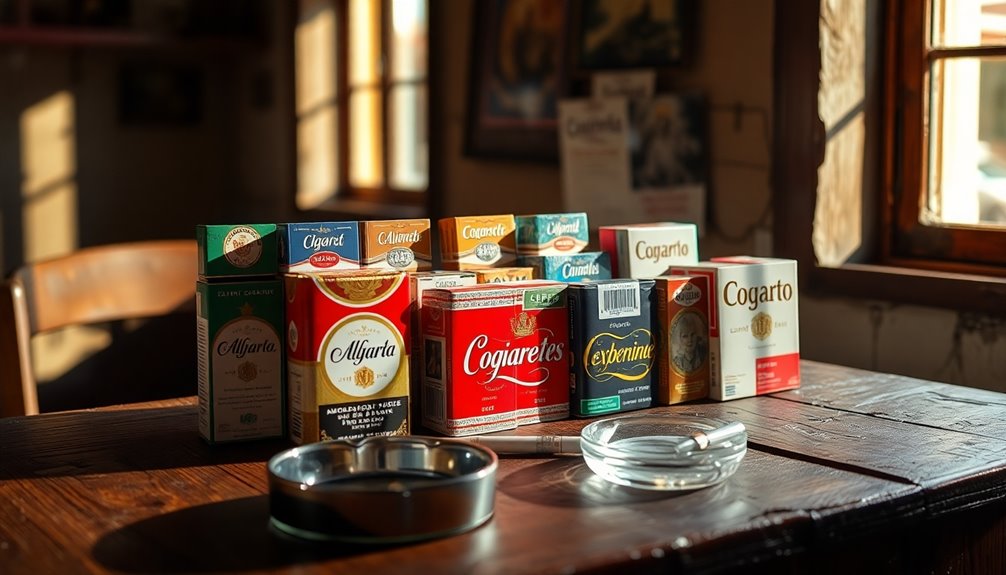
Tactics employed by the tobacco industry in Mexico reveal a persistent effort to undermine public health initiatives. The industry often uses lobbying tactics through third parties to influence tobacco control policies, making it difficult for regulators to enforce smoke-free policies effectively.
During the COVID-19 pandemic, you've likely noticed increased youth marketing through social media, where the industry cleverly promotes corporate social responsibility initiatives to enhance its public image.
Despite bans on advertising and product displays, tobacco companies engage in indirect promotion by sponsoring events and participating in community activities, subtly pushing their products into public consciousness. This manipulation of public sentiment complicates efforts to protect vulnerable populations, particularly youth.
Additionally, the illicit tobacco trade complicates regulatory enforcement, accounting for 8.8% of the market in 2021. This trade not only undermines public health efforts but also fuels the industry's ability to evade stricter regulations.
As the tobacco industry continues to resist updates to tobacco control laws that expand smoke-free zones, the battle for public health remains a challenging one against these persistent interference tactics.
Environmental Concerns
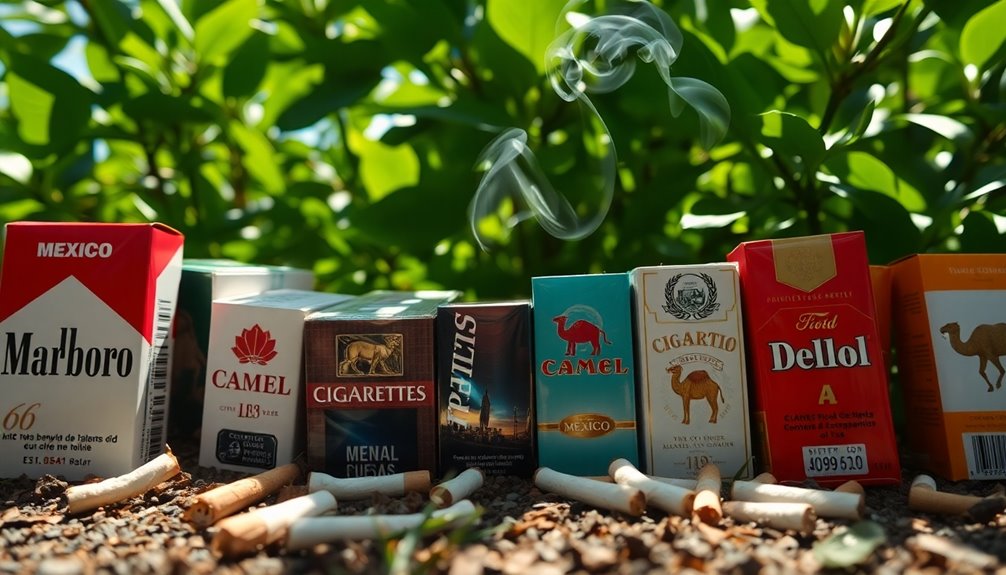
The ongoing interference tactics of the tobacco industry not only affect public health but also have significant environmental repercussions. As you explore the impact of cigarette consumption in Mexico, consider these alarming facts:
- Water Consumption: Producing around 40 billion cigarettes annually requires between 109 and 205 billion liters of water.
- CO2 Emissions: The tobacco industry emits between 20,000 and 29,000 tonnes of CO2 each year, contributing to climate change.
- Cigarette Butts: Daily disposal of 55 million cigarette butts incurs an annual cleanup cost of about US$140 million.
- Deforestation: Tobacco farming leads to habitat loss and raises concerns about the ecological footprint of tobacco agriculture.
While Corporate Social Responsibility initiatives, like PMI's Eco Filter program, may seem like a step forward, they often mask these broader negative environmental impacts.
The truth is, the tobacco industry's practices result in severe ecological degradation. From water depletion to deforestation, the environmental impact is profound and troubling.
As you weigh the costs of smoking, both to health and the environment, it's vital to recognize these significant concerns.
Future of Cigarette Brands

As regulatory pressures mount and consumer preferences shift, the future of cigarette brands in Mexico looks increasingly complex.
With stricter smoke-free laws impacting traditional brands, companies must adapt quickly to stay relevant. E-cigarettes and alternative tobacco products are expected to gain traction as consumers lean toward perceived safer options and innovative flavors.
To maintain a competitive edge, brand innovation is vital. Traditional brands must evolve by offering reduced-harm products and unique offerings that align with changing preferences.
Economic factors, including disposable income levels, will also play a significant role in how consumers spend on tobacco products, influencing overall market dynamics.
Long-term health trends and rising awareness of smoking-related illnesses are reshaping the landscape, prompting brands to enhance transparency.
Sustainability initiatives are becoming essential, as consumers increasingly prioritize environmentally friendly practices. This shift will challenge traditional brands to rethink their strategies and embrace more responsible production methods.
In this evolving market, the brands that thrive will be those that not only comply with regulations but also genuinely respond to consumer demands for healthier, innovative, and sustainable options.
Frequently Asked Questions
What Is the Most Popular Cigarette in Mexico?
If you're curious about the most popular cigarette in Mexico, you'll find that Marlboro stands out as the top choice among smokers.
With a market share exceeding 48%, it dominates the landscape, appealing to a wide audience.
Following closely is Pall Mall, which attracts younger smokers with its trendy appeal.
As you explore options, keep in mind the rising popularity of flavor capsule cigarettes, which cater to youth preferences.
What Kind of Cigarettes Do Mexicans Smoke?
Smoking's seductive allure captivates many in Mexico, where you'll find a variety of cigarettes lighting up the market.
Most folks gravitate towards popular brands like Marlboro and Pall Mall, which dominate sales.
Flavor capsule cigarettes are especially appealing to younger smokers, making up a significant share of the market.
With around 19% of adults puffing away, the smoking landscape reflects both tradition and shifting trends among demographics, particularly among men.
What Are the Top 3 Brands of Cigarettes?
When you're looking for the top three cigarette brands, Marlboro leads the pack with over 48% market share, making it the most popular choice.
Next up is Pall Mall, which holds nearly 22% of the market, thanks to its variety.
Finally, Chesterfield rounds out the top three, known for its flavorful options that attract a loyal following.
These brands reflect strong consumer preferences in the cigarette market.
What Is the Most Luxurious Cigarette Brand?
Imagine slipping into a tailored suit; that's what smoking Benson & Hedges feels like.
It's often regarded as the most luxurious cigarette brand, catering to those who appreciate elegance and quality.
With its premium offerings and striking packaging, it appeals directly to high-income smokers.
The Gold and Lux Amber variants represent sophistication, often associated with exclusive events.
If you're seeking a refined experience, you won't find a better choice than Benson & Hedges.
Conclusion
As you explore the dynamic landscape of cigarette brands in Mexico, it's clear that the market's evolution mirrors shifts in society, much like the rise of automobiles in the early 20th century. While traditional brands still hold sway, changing consumer preferences and stringent regulations are reshaping the industry's future. As you consider your own choices, remember that awareness of health impacts and environmental concerns can guide you toward making informed decisions in this smoky world.
